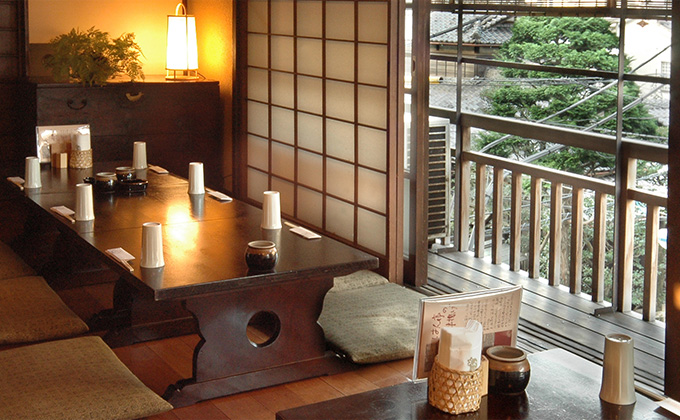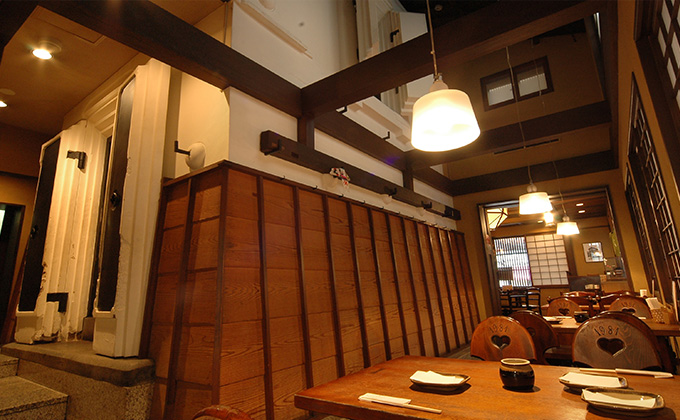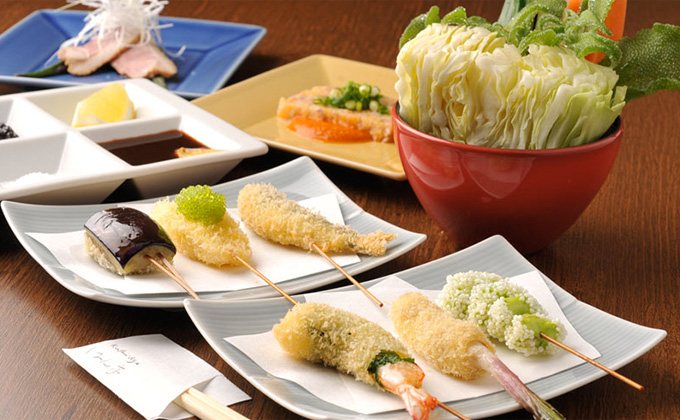Kushiage Hantei
STORE INTRODUCTION
Savor your dinner in a registered tangible cultural property.
Hantei is designated by the Agency for Cultural Affairs as a registered tangible cultural property, because it is a valuable establishment built in the Meiji era. It is a three-story, all-zelkova building which withstood the Great Kato Earthquake! This kind of Japanese-style building is very rare, even in Japan, and can seldom be seen. From the tatami rooms on the second and third floors, the roofing tiles can be seen close up, and you can feel the friendly “shitamachi” atmosphere of this traditional, working-class neighborhood.
Various seats
Most of the seats in this restaurant are in tatami rooms where you can relax with your shoes off, and enjoy your meals in an atmosphere unique to Japan. In the first floor interior stands a dozo (an old storehouse with thick walls). The first floor table seats, where you can enjoy your meals while viewing the dozo, are popular. There is also a tatami room inside the dozo which can be used as a private room for seven to eleven people. In addition, there is a private room with table seats for four to five people (We kindly ask for a fee of 3,000 yen for the use of the room). If you have any requests about seating, just call a member of our staff.
How to enjoy your dinner at Hantei
Your dinner at Hantei starts with “Ichi-no-zen,” a combo of six kushiage, two small appetizers and fresh vegetables. With the kushiage, we would like you to savor foodstuffs in season, that are most delicious at the time of your visit, so please leave the choice of ingredients to the staff. Needless to say, feel free to tell the staff if there are any foodstuffs that you don’t care for. Ours is a style in which you taste each combo of kushiage one by one, and if you are still hungry, you can order another combo (or a half combo of three). We always have more than thirty kinds of ingredients for kushiage. They are different from season to season, but for “Ichi-no-zen” and “Ni-no-zen” we use both standard ingredients and ones in season, and from “San-no-zen” on, you will experience the real thrill of savoring kushiage. If you finish the final combo, you might become a “Master of Kushiage!?”
Paying the bill
You can pay your bill at your table or at the cash register near the entrance.
The History of the Hantei Building
Kushiage Hantei Nezu’s flagship restaurant is housed in an old wooden building. This is the story of a local landmark building in the Nezu area.
The Nezu area, in Chuo-ku, Tokyo, used to be deep inside of the bay when the city of Edo was under the sea. After the seawater dissipated, a river appeared and that river eventually became a road. In the 19th century, merchant houses stood side by side along the street. Later on, a merchant house called Mita Shoten came into existence, which made and sold tsumakawa. Tsumakawa is a kind of flap to cover the tip of geta (traditional Japanese wooden sandals) that protects the wearer’s feet from rain and mud. Tsumakawa were essential at that time because the streets soon became muddy when it rained. Thus, Mita Shoten enjoyed prosperity.
As was typical of a large merchant during those times, Mita Shoten further thrived. In 1909, the building extended its second floor, and in 1917, it added on a third level. The building, built entirely with Japanese zelkova, was beautiful and strong. It endured the strong tremors of the Great Kanto Earthquake in 1923 and also survived World War II.
This wooden structure currently houses Hantei Nezu ’s flagship restaurant, but it took a while for Hantei to acquire the building. After the war, the era of tsumakawa came to an end because of the emergence of western-style shoes, and Mita Shoten had to give up its home. It was handed over to a new company and used as a dormitory. Around that time, the owner of Hantei first noticed this building. Attracted by the beauty of the all-wood structure that had existed for years, the head of Hantei negotiated ownership of the building.
Hantei gained possession of the building a few years later and, as it was in poor condition, set to work restoring it. Carpenters and craft workers felt empathy for the owner, who did not want to change the appearance of the building. He wanted to welcome guests, while maintaining the same impression that he had had when he first encountered the site. Some time later, the building started its new life as Kushiage Hantei and began to draw people’s fascination. Around that time, the name of the building was changed to Hantei. The owner did so with the idea that he would like to take a step forward from this new place.
The Hantei Building, constructed at the beginning of the 20th century, has a 100-year history and is still in use. It was designated as a National Tangible Cultural Property in 1999, and bears a plaque that reads: “A Precious Legacy of the Japanese People.”



